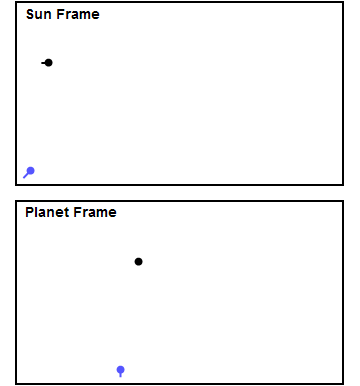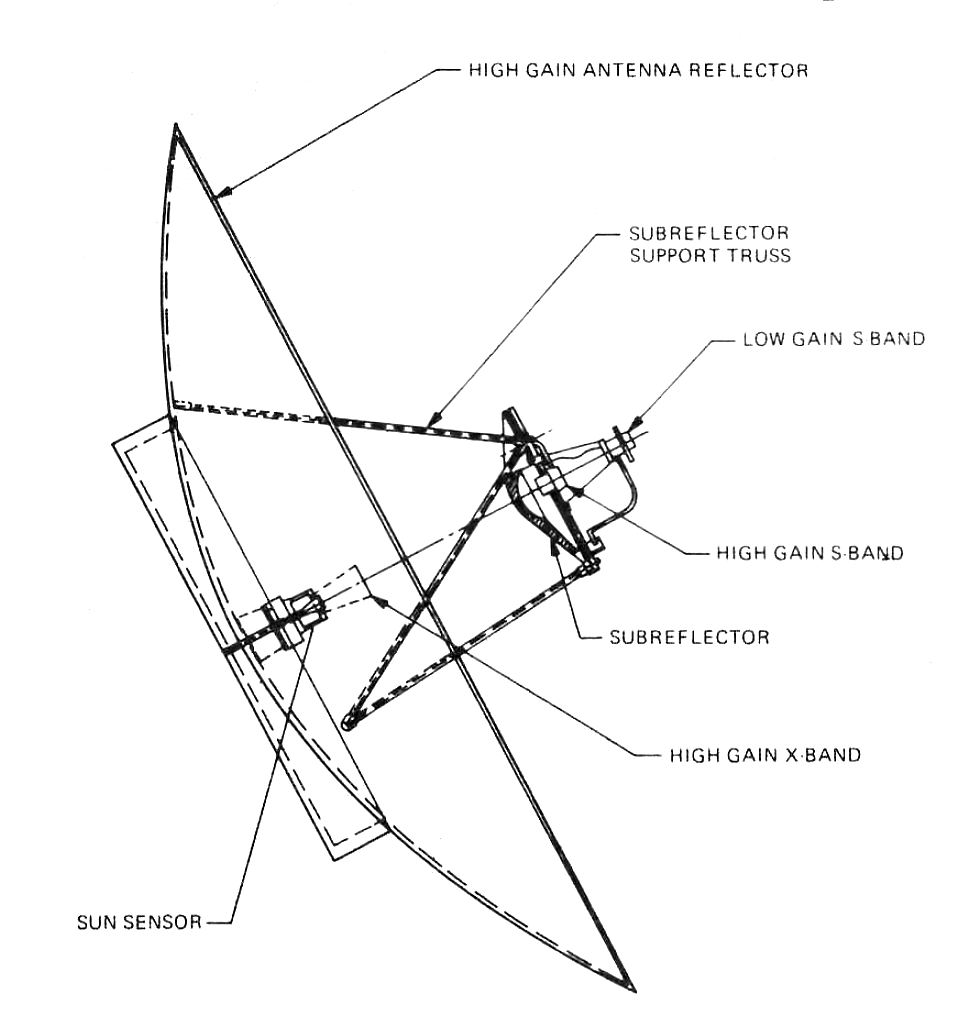|
Gravity Assist
In orbital mechanics and aerospace engineering, a gravitational slingshot, gravity assist maneuver, or swing-by is the use of the relative movement (e.g. orbit around the Sun) and gravity of a planet or other astronomical object to alter the path and speed of a spacecraft, typically to save propellant and reduce expense. Gravity assistance can be used to accelerate a spacecraft, that is, to increase or decrease its speed or redirect its path. The "assist" is provided by the motion of the gravitating body as it pulls on the spacecraft. Any gain or loss of kinetic energy and velocity by a passing spacecraft is correspondingly lost or gained by the gravitational body, in accordance with Newton's Third Law. The gravity assist maneuver was first used in 1959 when the Soviet probe Luna 3 photographed the far side of Earth's Moon and it was used by interplanetary probes from Mariner 10 onward, including the two Voyager probes' notable flybys of Jupiter and Saturn. Explanation A ... [...More Info...] [...Related Items...] OR: [Wikipedia] [Google] [Baidu] |
Voyager 1
''Voyager 1'' is a space probe launched by NASA on September 5, 1977, as part of the Voyager program to study the outer Solar System and interstellar space beyond the Sun's heliosphere. Launched 16 days after its twin '' Voyager 2'', ''Voyager 1'' has been operating for as of . It communicates through NASA's Deep Space Network to receive routine commands and to transmit data to Earth. Real-time distance and velocity data is provided by NASA and JPL. At a distance of from Earth , it is the most distant human-made object from Earth. The probe made flybys of Jupiter, Saturn, and Saturn's largest moon, Titan. NASA had a choice of either doing a Pluto or Titan flyby; exploration of the moon took priority because it was known to have a substantial atmosphere. ''Voyager 1'' studied the weather, magnetic fields, and rings of the two gas giants and was the first probe to provide detailed images of their moons. As part of the Voyager program and like its sister craft '' Voy ... [...More Info...] [...Related Items...] OR: [Wikipedia] [Google] [Baidu] |
Accelerate
In mechanics, acceleration is the rate of change of the velocity of an object with respect to time. Accelerations are vector quantities (in that they have magnitude and direction). The orientation of an object's acceleration is given by the orientation of the ''net'' force acting on that object. The magnitude of an object's acceleration, as described by Newton's Second Law, is the combined effect of two causes: * the net balance of all external forces acting onto that object — magnitude is directly proportional to this net resulting force; * that object's mass, depending on the materials out of which it is made — magnitude is inversely proportional to the object's mass. The SI unit for acceleration is metre per second squared (, \mathrm). For example, when a vehicle starts from a standstill (zero velocity, in an inertial frame of reference) and travels in a straight line at increasing speeds, it is accelerating in the direction of travel. If the vehicle turns, an ... [...More Info...] [...Related Items...] OR: [Wikipedia] [Google] [Baidu] |
Hyperbola
In mathematics, a hyperbola (; pl. hyperbolas or hyperbolae ; adj. hyperbolic ) is a type of smooth curve lying in a plane, defined by its geometric properties or by equations for which it is the solution set. A hyperbola has two pieces, called connected components or branches, that are mirror images of each other and resemble two infinite bows. The hyperbola is one of the three kinds of conic section, formed by the intersection of a plane and a double cone. (The other conic sections are the parabola and the ellipse. A circle is a special case of an ellipse.) If the plane intersects both halves of the double cone but does not pass through the apex of the cones, then the conic is a hyperbola. Hyperbolas arise in many ways: * as the curve representing the reciprocal function y(x) = 1/x in the Cartesian plane, * as the path followed by the shadow of the tip of a sundial, * as the shape of an open orbit (as distinct from a closed elliptical orbit), such as the orb ... [...More Info...] [...Related Items...] OR: [Wikipedia] [Google] [Baidu] |
Frame Of Reference
In physics and astronomy, a frame of reference (or reference frame) is an abstract coordinate system whose origin, orientation, and scale are specified by a set of reference points― geometric points whose position is identified both mathematically (with numerical coordinate values) and physically (signaled by conventional markers). For ''n'' dimensions, reference points are sufficient to fully define a reference frame. Using rectangular Cartesian coordinates, a reference frame may be defined with a reference point at the origin and a reference point at one unit distance along each of the ''n'' coordinate axes. In Einsteinian relativity, reference frames are used to specify the relationship between a moving observer and the phenomenon under observation. In this context, the term often becomes observational frame of reference (or observational reference frame), which implies that the observer is at rest in the frame, although not necessarily located at its origin. A r ... [...More Info...] [...Related Items...] OR: [Wikipedia] [Google] [Baidu] |
Elastic Collision
In physics, an elastic collision is an encounter ( collision) between two bodies in which the total kinetic energy of the two bodies remains the same. In an ideal, perfectly elastic collision, there is no net conversion of kinetic energy into other forms such as heat, noise, or potential energy. During the collision of small objects, kinetic energy is first converted to potential energy associated with a repulsive or attractive force between the particles (when the particles move against this force, i.e. the angle between the force and the relative velocity is obtuse), then this potential energy is converted back to kinetic energy (when the particles move with this force, i.e. the angle between the force and the relative velocity is acute). Collisions of atoms are elastic, for example Rutherford backscattering. A useful special case of elastic collision is when the two bodies have equal mass, in which case they will simply exchange their momenta. The ''molecules''—as dis ... [...More Info...] [...Related Items...] OR: [Wikipedia] [Google] [Baidu] |
Velocity
Velocity is the directional speed of an object in motion as an indication of its rate of change in position as observed from a particular frame of reference and as measured by a particular standard of time (e.g. northbound). Velocity is a fundamental concept in kinematics, the branch of classical mechanics that describes the motion of bodies. Velocity is a physical vector quantity; both magnitude and direction are needed to define it. The scalar absolute value ( magnitude) of velocity is called , being a coherent derived unit whose quantity is measured in the SI ( metric system) as metres per second (m/s or m⋅s−1). For example, "5 metres per second" is a scalar, whereas "5 metres per second east" is a vector. If there is a change in speed, direction or both, then the object is said to be undergoing an ''acceleration''. Constant velocity vs acceleration To have a ''constant velocity'', an object must have a constant speed in a constant direction. Constant dir ... [...More Info...] [...Related Items...] OR: [Wikipedia] [Google] [Baidu] |
Planetary Flyby
A planetary flyby is the act of sending a space probe past a planet or a dwarf planet close enough to record scientific data. This is a subset of the overall concept of a flyby in spaceflight. The first flyby of another planet with a functioning spacecraft took place on December 14, 1962, when Mariner 2 zoomed by the planet Venus. Planetary flybys are commonly used as gravity assist maneuvers to "slingshot" a space probe toward its primary target without expending fuel, but in some cases (such as with New Horizons), flybys are the primary objectives of a mission in of themselves. A relatively recent example of a flyby spacecraft is ''New Horizons,'' which performed flyby maneuvers of Jupiter, Pluto and its moons in the 21st century. The flyby of Jupiter, used as a gravity assist, allowed the craft to reach Pluto at high velocity without the complications of slowing down, after which it proceeded further into the Kuiper Belt on an escape trajectory out of the Solar System. L ... [...More Info...] [...Related Items...] OR: [Wikipedia] [Google] [Baidu] |
Voyager Program
The Voyager program is an American scientific program that employs two robotic interstellar probes, ''Voyager 1'' and ''Voyager 2''. They were launched in 1977 to take advantage of a favorable alignment of Jupiter and Saturn, to fly near them while collecting data for transmission back to Earth. After launch the decision was taken to send ''Voyager 2'' near Uranus and Neptune to collect data for transmission back to Earth. As of 2022, the Voyagers are still in operation past the outer boundary of the heliosphere in interstellar space. They collect and transmit useful data to Earth. , ''Voyager 1'' was moving with a velocity of , or 17 km/s, relative to the Sun, and was from the Sun reaching a distance of from Earth as of February 10, 2022. On 25 August 2012, data from ''Voyager 1'' indicated that it had entered interstellar space. , ''Voyager 2'' was moving with a velocity of , or 15 km/s, relative to the Sun, and was from the Sun reaching a distance of from Ear ... [...More Info...] [...Related Items...] OR: [Wikipedia] [Google] [Baidu] |
Mariner 10
''Mariner 10'' was an American robotic space probe launched by NASA on 3 November 1973, to fly by the planets Mercury and Venus. It was the first spacecraft to perform flybys of multiple planets. ''Mariner 10'' was launched approximately two years after ''Mariner 9'' and was the last spacecraft in the Mariner program. (Mariner 11 and Mariner 12 were allocated to the Voyager program and redesignated ''Voyager 1'' and ''Voyager 2''.) The mission objectives were to measure Mercury's environment, atmosphere, surface, and body characteristics and to make similar investigations of Venus. Secondary objectives were to perform experiments in the interplanetary medium and to obtain experience with a dual-planet gravity assist mission. ''Mariner 10''s science team was led by Bruce C. Murray at the Jet Propulsion Laboratory. Design and trajectory ''Mariner 10'' was the first spacecraft to make use of an interplanetary gravitational slingshot maneuver, using Venus to bend it ... [...More Info...] [...Related Items...] OR: [Wikipedia] [Google] [Baidu] |
Moon
The Moon is Earth's only natural satellite. It is the fifth largest satellite in the Solar System and the largest and most massive relative to its parent planet, with a diameter about one-quarter that of Earth (comparable to the width of Australia). The Moon is a planetary-mass object with a differentiated rocky body, making it a satellite planet under the geophysical definitions of the term and larger than all known dwarf planets of the Solar System. It lacks any significant atmosphere, hydrosphere, or magnetic field. Its surface gravity is about one-sixth of Earth's at , with Jupiter's moon Io being the only satellite in the Solar System known to have a higher surface gravity and density. The Moon orbits Earth at an average distance of , or about 30 times Earth's diameter. Its gravitational influence is the main driver of Earth's tides and very slowly lengthens Earth's day. The Moon's orbit around Earth has a sidereal period of 27.3 days. During each synod ... [...More Info...] [...Related Items...] OR: [Wikipedia] [Google] [Baidu] |



